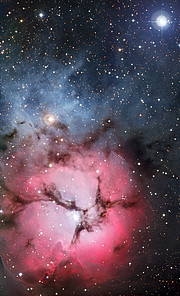Pressemitteilung
Dreifacher Trifidnebel
26. August 2009
Heute von der Europäischen Südsternwarte ESO veröffentlichte Bilder zeigen, warum der Trifidnebel ein Lieblingsobjekt der Amateur- wie der Profiastronomen ist. Die massereiche Sternenfabrik, deren Name sich von der deutlich sichtbaren Dreiteilung des Nebels ableitet, ist eine seltene Kombination dreier verschiedener Typen von Nebel. Im Trifidnebel zeigt sich zum einen die stürmische Aktivität junger Sterne, zum anderen finden sich Hinweise auf Sterne, die gerade erst im Entstehen begriffen sind.
Der Trifidnebel im Sternbild Schütze, mehrere Tausend Lichtjahre von der Erde entfernt, ist ein regelrechtes Genrebild der Kindheit und Jugend von Sternen. Die Hitze und Teilchenströme junger Sterne, deren Kernbrennprozesse gerade erst gezündet haben, durchmischen das Gas und den Staub des Trifidnebels; die dunklen Wolken, die dem Nebel sein charakteristisches Aussehen verleihen, werden in Zukunft selbst einmal kollabieren und neue Sterne hervorbringen.
Erstmals beobachtet wurde der Nebel im Juni 1764 von dem französischen Astronomen Charles Messier, der das diffus leuchtende Objekt mit der Ordnungsnummer 20 in den nach ihm benannten Katalog aufnahm. Mehr als 60 Jahre später prägte der englische Astronom John Herschel angesichts der dreigeteilten Struktur des Objekts den heute noch gültigen Namen “Trifid” (nach dem lateinischen Ausdruck für dreigespalten oder dreigeteilt).
Die neuen Bilder wurden mit dem Wide-Field Imager angefertigt, einer astronomischen Kamera mit besonders großem Blickfeld, die am MPG/ESO 2,2-Meter-Teleskop am ESO-Standort La Silla angebracht ist. Deutlich lassen sich darauf die verschiedenen Regionen des Trifidnebels auseinanderhalten. Bei der bläulichen Region oben links handelt es sich um einen Reflexionsnebel: das an Staubwolken reflektierte Licht von Sternen, die im Trifidnebel geboren wurden. Der größte der Sterne ist in der heißen, blauen Region des elektromagnetischen Spektrums besonders leuchtkräftig. Zusammen mit dem Umstand, dass Staubteilchen und Moleküle blaues Licht effektiver streuen als rotes Licht – daher sehen wir einen blauen Himmel und rötliche Sonnenuntergänge – sorgt für die bläuliche Farbe dieses Teils des Trifidnebels.
Bei der gerundeten, rosafarbenen Region direkt darunter handelt es sich um einen Emissionsnebel. Hier wird das Gas des Trifidnebels durch besonders heiße junge Sterne aufgeheizt, so dass es das für Wasserstoff – das dort häufigste Gas – charakteristische rötliche Licht aussendet. Ähnlich funktionieren Neonlampen, deren heißes Neongas rötlich-oranges Licht aussendet.
Die Gas- und Staubwolken, die den Trifidnebel durchziehen, sind Vertreter der dritten Nebelart: kosmische Dunkelwolken, die, wie ihr Name sagt, für Licht so gut wie undurchsichtig sind. (Bekanntestes Beispiel für eine Dunkelwolke dürfte der Pferdekopfnebel sein, siehe [ESO Press Photo 02/02]). Solche Dunkelwolken sind die Geburtsstätten von Sternen der nächsten Generation. Dichtere Regionen im Inneren der Wolken ziehen sich unter dem Einfluss ihrer eigenen Schwerkraft immer weiter zusammen, bis Dichte, Druck und Temperatur der Region soweit angestiegen sind, dass es zur Kernfusion kommt – und ein neuer Stern geboren ist.
Im unteren Teil des Nebels wird die Wolke von einem länglichen Gasfinger durchstochen, der direkt auf den Zentralstern des Trifidnebels zeigt. Dabei handelt es sich um ein EGG-Objekt (eine evaporating gaseous globule, wörtlich: “verdampfende Gas-Globule”), in dem ebenfalls Sterne entstehen. Das Weltraumteleskop Hubble hat eine beeindruckend detailreiche Aufnahme der Fingerspitze geliefert, einer Region dichten Gases, das dem Strahlungsansturm des massereichen Sterns bislang widerstanden hat.
Weitere Informationen
Das MPG/ESO 2,2-Meter-Teleskop wurde 1984 in Betrieb genommen und ist eine Leihgabe der Max-Planck-Gesellschaft an ESO. Sein Wide Field Imager, eine astronomische Kamera mit besonders großem Blickfeld und einem Detektor mit 67 Millionen Pixeln, liefert Bilder, die nicht nur von wissenschaftlichem, sondern auch von ästhetischem Wert sind.
Die Europäische Südsternwarte ESO (European Southern Observatory) ist die führende europäische Organisation für astronomische Forschung und das wissenschaftlich produktivste Observatorium der Welt. Getragen wird die Organisation durch ihre 14 Mitgliedsländer: Belgien, Dänemark, Deutschland, Finnland, Frankreich, Italien, die Niederlande, Österreich, Portugal, Spanien, Schweden, die Schweiz, die Tschechische Republik und das Vereinigte Königreich. Die ESO ermöglicht astronomische Spitzenforschung, indem sie leistungsfähige bodengebundene Teleskope entwirft, konstruiert und betreibt. Auch bei der Förderung internationaler Zusammenarbeit auf dem Gebiet der Astronomie spielt die Organisation eine maßgebliche Rolle. Die ESO betreibt drei weltweit einzigartige Beobachtungsstandorte in Nordchile: La Silla, Paranal und Chajnantor. Auf Paranal betreibt die ESO mit dem Very Large Telescope (VLT) das weltweit leistungsfähigste Observatorium für Beobachtungen im Bereich des sichtbaren Lichts. Die ESO ist der europäische Partner für den Aufbau des Antennenfelds ALMA, das größte astronomische Projekt überhaupt. Derzeit entwickelt die ESO das European Extremely Large Telescope (E-ELT) für Beobachtungen im Bereich des sichtbaren und Infrarotlichts, mit 42 Metern Spiegeldurchmesser ein Großteleskop der Extraklasse.
Kontaktinformationen
Carolin Liefke
ESO Science Outreach Network, Haus der Astronomie
Tel: (06221) 528 226
E-Mail: eson@mpia.de
Henri Boffin
ESO
Garching, Germany
Tel: +49 89 3200 6222
E-Mail: hboffin@eso.org
Über die Pressemitteilung
| Pressemitteilung Nr.: | eso0930de |
| Legacy ID: | PR 30/09 |
| Name: | Trifid Nebula |
| Typ: | Milky Way : Nebula : Type : Star Formation |
| Facility: | MPG/ESO 2.2-metre telescope |
| Instruments: | WFI |



